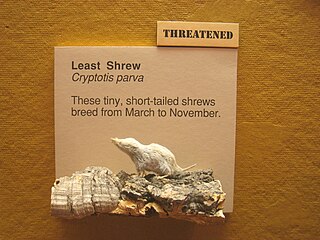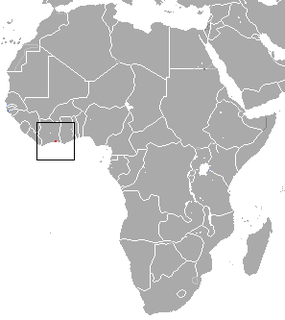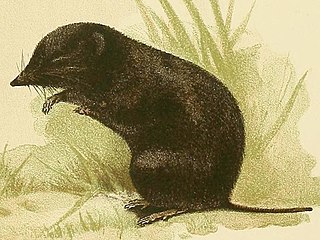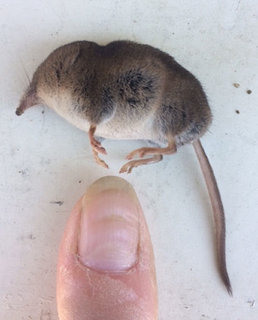
Shrews are small mole-like mammals classified in the order Eulipotyphla. True shrews are not to be confused with treeshrews, otter shrews, elephant shrews, West Indies shrews, or marsupial shrews, which belong to different families or orders.

The barren ground shrew is a small shrew found in northern Canada west of Hudson Bay and in Alaska. At one time, this species was considered to be a subspecies of the similar cinereus shrew. It is similar in appearance and thought to be closely related to the Saint Lawrence Island shrew and Pribilof Island shrew.

The genus Blarina is a group of relatively large shrews with relatively short tails found in North America. They have 32 teeth and are in the red-toothed shrew subfamily.

The genus Cryptotis is a group of relatively small shrews with short ears, which are usually not visible, and short tails, commonly called small-eared shrews. They have 30 teeth and are members of the red-toothed shrew subfamily. Since 1992, Neal Woodman at the United States National Museum has been in the process of revising the genus. To date, this has resulted in an increase in the number of species from 12 to 30.

The shrew moles or shrew-like moles (Uropsilus) are shrew-like members of the mole family of mammals endemic to the forested, high-alpine region bordering China, Myanmar, and Vietnam. They possess a long snout, a long slender tail, external ears, and small forefeet unspecialized for burrowing. Although they are similar to shrews in size, external appearance, and, presumably, ecological habits, they are nevertheless talpids and considered true moles, as they share a full zygomatic arch with all other moles, while this arch is completely absent in shrews.

The Eurasian pygmy shrew, often known simply as the pygmy shrew, is a widespread shrew of the northern Palearctic.

Elliot's short-tailed shrew is a small, slate grey, short-tailed species of shrew. Its common name comes from Daniel Giraud Elliot, who first described the species in 1899.

The lesser white-toothed shrew is a tiny shrew with a widespread distribution in Africa, Asia and Europe. Its preferred habitat is scrub and gardens and it feeds on insects, arachnids, worms, gastropods, newts and small rodents, though its diet usually varies according to the biotope where it lives. The closely related Asian lesser white-toothed shrew was once included in this species, but is now considered to be a separate species.

Wimmer's shrew is a white-toothed shrew found only in Côte d'Ivoire. It is listed as a critically endangered species due to habitat loss and a restricted range.

Suncus is a genus of shrews in the family Soricidae.

Notiosorex is a genus of shrew from the subfamily Soricinae.

The Asiatic water shrews are the members of the genus Chimarrogale. They are mammals in the subfamily Soricinae of the family Soricidae. They are aquatic, with some species inhabiting streams. The genus contains the following species:
The Congo shrews, members of the genus Congosorex, are mammals in the family Soricidae. The genus contains these species:

Myosorex is a mammal genus in the Soricidae (shrew) family. The genus, collectively referred to as the mouse shrews, contains these species:
Paracrocidura is a genus of shrews. They are mammals in the family Soricidae. The vernacular name large-headed shrews is sometimes collectively applied to the genus, but has also been applied to the species Crocidura grandiceps.

The Arizona shrew is a species of shrew native to North America.

The forest shrews are the members of the genus Sylvisorex. They are mammals in the family Soricidae and are found only in Africa. The genus name comes from the Latin world "silva" which means "forest" and "sorex", which means "shrew-mouse". This reflects the nature of these shrews, which prefer forest habitats. All shrews are carnivorous, and eat continually to satisfy their high metabolic rate.

The southeastern shrew is a species of mammal in the family Soricidae. It is found in the southeastern United States.

Asian mole shrews (Anourosorex) are a genus of shrews that resemble moles, from China, Taiwan, India, and Indochina. They are the only known genus of the Anourosoricini tribe of red-toothed shrews. The four known species are:

The long-tailed shrew or rock shrew is a small shrew found in Atlantic Canada and the Northeastern United States.


















